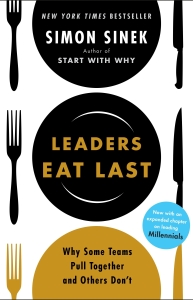
Imagine a world where almost everyone wakes up inspired to go to work. This is not a crazy, idealised notion. In many successful organisations, great leaders are creating environments in which teams trust each other so deeply that they would put their lives on the line for each other. Yet other teams, no matter what incentives were offered, are doomed to infighting, fragmentation and failure. Why? Today's workplaces tend to be full of cynicism, paranoia and self-interest. But the best organisations foster trust and cooperation because their leaders build what Sinek calls a Circle of Safety.
CHAPTER 1: Protection from Above
A thick layer of clouds blocked out any light. There were no stars and there was no moon. Just black. The team slowly made its way through the valley, the rocky terrain making it impossible to go any faster than a snail’s pace. Worse, they knew they were being watched. Every one of them was on edge.
A year hadn’t yet passed since the attacks of September 11. The Taliban government had only recently fallen after taking a pounding from U.S. forces for their refusal to turn over the Al Qaeda leader, Osama bin Laden. There were a lot of Special Operations Forces in the area performing missions that, to this day, are still classified. This was one of those teams and this was one of those missions.
All we know is that the team of twenty-two men was operating deep inside enemy territory and had recently captured what the government calls a “high-value target.” They were now working their way through a deep valley in a mountainous part of Afghanistan, escorting their high-value target to a safe house.
Flying over the thick clouds that night was Captain Mike Drowley, or Johnny Bravo, as he is known by his call sign or nickname. Except for the whir of his engines, it was perfectly peaceful up there. Thousands of stars speckled the sky, and the moon lit up the top of the clouds so brightly it looked like a fresh layer of snow had fallen. It was beautiful.
“Knowing someone is looking out for them, gives the troops below a greater sense of confidence.”
Johnny Bravo and his wingman were circling above in their A-10 aircraft, waiting should they be needed below. Affectionately known as the Warthog, the A-10 is not technically a fighter jet; it’s an attack aircraft. A relatively slow-flying, single-seat armored plane designed to provide close air support for troops on the ground. Unlike other fighter jets, it is not fast or sexy (hence the nickname), but it gets the job done.
Ideally, both the A-10 pilots in the air and the troops on the ground would prefer to see each other with their eyes. Seeing the plane above, knowing someone is looking out for them, gives the troops below a greater sense of confidence. And seeing the troops below gives the pilots a greater sense of assurance that they will be able to help if needed. But given the thick cloud cover and the mountainous terrain that night in Afghanistan, the only way either knew the other was there was through the occasional radio contact they kept. Without a line of sight, Johnny Bravo couldn’t see what the troops saw, but he could sense how the troops felt from what he heard over the radio. And this was enough to spur him to act.
Following his gut, Johnny Bravo decided he needed to execute a weather letdown, to drop down below the clouds so he could take a look at what was happening on the ground. It was a daring move. With the thick, low-hanging clouds, scattered storms in the area and the fact that Johnny Bravo would have to fly into a valley with his field of vision reduced by the night-vision goggles, performing the weather letdown under these conditions was extremely treacherous for even the most experienced of pilots.
Extracted from Leaders Eat Last by Simon Sinek, out now.
YOU MAY ALSO ENJOY
Extract: Start with Why by Simon Sinek









